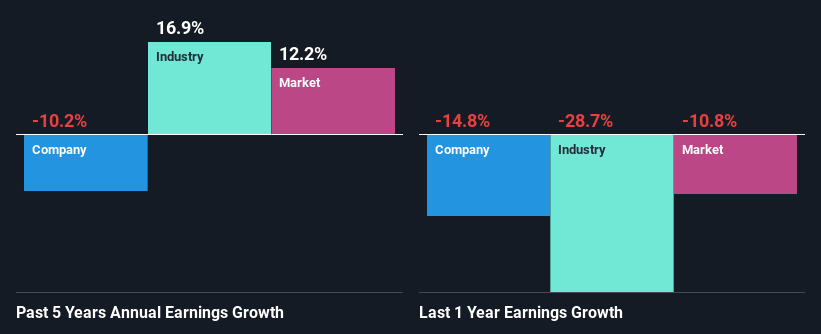Stock Analysis
- Taiwan
- /
- Semiconductors
- /
- TWSE:2340
Are Poor Financial Prospects Dragging Down Taiwan-Asia Semiconductor Corporation (TWSE:2340 Stock?

Taiwan-Asia Semiconductor (TWSE:2340) has had a rough three months with its share price down 16%. Given that stock prices are usually driven by a company’s fundamentals over the long term, which in this case look pretty weak, we decided to study the company's key financial indicators. Specifically, we decided to study Taiwan-Asia Semiconductor's ROE in this article.
Return on equity or ROE is an important factor to be considered by a shareholder because it tells them how effectively their capital is being reinvested. In simpler terms, it measures the profitability of a company in relation to shareholder's equity.
Check out our latest analysis for Taiwan-Asia Semiconductor
How Is ROE Calculated?
The formula for return on equity is:
Return on Equity = Net Profit (from continuing operations) ÷ Shareholders' Equity
So, based on the above formula, the ROE for Taiwan-Asia Semiconductor is:
3.6% = NT$304m ÷ NT$8.5b (Based on the trailing twelve months to December 2023).
The 'return' is the income the business earned over the last year. One way to conceptualize this is that for each NT$1 of shareholders' capital it has, the company made NT$0.04 in profit.
What Has ROE Got To Do With Earnings Growth?
Thus far, we have learned that ROE measures how efficiently a company is generating its profits. Depending on how much of these profits the company reinvests or "retains", and how effectively it does so, we are then able to assess a company’s earnings growth potential. Generally speaking, other things being equal, firms with a high return on equity and profit retention, have a higher growth rate than firms that don’t share these attributes.
Taiwan-Asia Semiconductor's Earnings Growth And 3.6% ROE
At first glance, Taiwan-Asia Semiconductor's ROE doesn't look very promising. Next, when compared to the average industry ROE of 9.6%, the company's ROE leaves us feeling even less enthusiastic. Given the circumstances, the significant decline in net income by 10% seen by Taiwan-Asia Semiconductor over the last five years is not surprising. However, there could also be other factors causing the earnings to decline. Such as - low earnings retention or poor allocation of capital.
That being said, we compared Taiwan-Asia Semiconductor's performance with the industry and were concerned when we found that while the company has shrunk its earnings, the industry has grown its earnings at a rate of 17% in the same 5-year period.

Earnings growth is a huge factor in stock valuation. It’s important for an investor to know whether the market has priced in the company's expected earnings growth (or decline). Doing so will help them establish if the stock's future looks promising or ominous. Is Taiwan-Asia Semiconductor fairly valued compared to other companies? These 3 valuation measures might help you decide.
Is Taiwan-Asia Semiconductor Using Its Retained Earnings Effectively?
Taiwan-Asia Semiconductor's very high three-year median payout ratio of 143% over the last three years suggests that the company is paying its shareholders more than what it is earning and this explains the company's shrinking earnings. Paying a dividend higher than reported profits is not a sustainable move. To know the 3 risks we have identified for Taiwan-Asia Semiconductor visit our risks dashboard for free.
Moreover, Taiwan-Asia Semiconductor has been paying dividends for at least ten years or more suggesting that management must have perceived that the shareholders prefer dividends over earnings growth.
Summary
Overall, we would be extremely cautious before making any decision on Taiwan-Asia Semiconductor. Specifically, it has shown quite an unsatisfactory performance as far as earnings growth is concerned, and a poor ROE and an equally poor rate of reinvestment seem to be the reason behind this inadequate performance. Up till now, we've only made a short study of the company's growth data. To gain further insights into Taiwan-Asia Semiconductor's past profit growth, check out this visualization of past earnings, revenue and cash flows.
Valuation is complex, but we're helping make it simple.
Find out whether Taiwan-Asia Semiconductor is potentially over or undervalued by checking out our comprehensive analysis, which includes fair value estimates, risks and warnings, dividends, insider transactions and financial health.
View the Free AnalysisHave feedback on this article? Concerned about the content? Get in touch with us directly. Alternatively, email editorial-team (at) simplywallst.com.
This article by Simply Wall St is general in nature. We provide commentary based on historical data and analyst forecasts only using an unbiased methodology and our articles are not intended to be financial advice. It does not constitute a recommendation to buy or sell any stock, and does not take account of your objectives, or your financial situation. We aim to bring you long-term focused analysis driven by fundamental data. Note that our analysis may not factor in the latest price-sensitive company announcements or qualitative material. Simply Wall St has no position in any stocks mentioned.
About TWSE:2340
Taiwan-Asia Semiconductor
Taiwan-Asia Semiconductor Corporation engages in the manufacture and sale of optoelectronic semiconductor integrated solutions in Taiwan and internationally.
Adequate balance sheet unattractive dividend payer.

